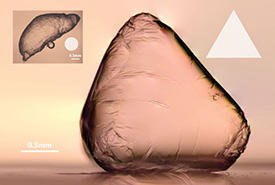

04/23/2018

From Ref. 1. Reprinted with permission from AAAS.
A fast, versatile and effective method to wrap liquids in thin polymer films, developed by an AIMR researcher and his collaborators, could be used to contain hazardous liquids and make containers for chemical reactants1.
Liquids are often encapsulated in other liquids; examples include emulsions used in the food industry and compounds for containing oil spills. But for some applications, a thin, solid wrapping would provide greater rigidity.
Now, Thomas Russell of the AIMR at Tohoku University, Narayanan Menon at the University of Massachusetts Amherst, along with two other collaborators in the USA, have devised a simple and elegant method that can encase liquid droplets in polymer films in a few tens of milliseconds.
Their straightforward technique involves simply releasing a drop of liquid from a specific height onto a small, thin polymer sheet floating on the surface of another liquid. As the drop sinks into the liquid, the polymer sheet wraps around it, encasing it completely. Surface tension ensures the seams that form in the polymer are nearly perfect with no gaps or overlaps.
Despite its simplicity, the method is highly versatile. Unlike conventional encapsulation strategies that generally produce only spherical droplets, the technique can produce capsules of different shapes by varying the shape of the polymer film (see image). Different combinations of liquids can be also used — in the study, the researchers performed wrapping by dropping both oil into water and water into oil. Russell notes that the approach could be extended to other encapsulating materials: “In this study, we used a polymer to wrap liquids, but any thin sheet that is highly bendable, including thin metal sheets, for example, could be used.”
The technique has many potential applications. “Since the sheets can be preconditioned or made from impermeable materials, they can easily be used to contain contaminants such as oil from a spill, toxic materials and highly reactive materials,” says Russell. “Furthermore, multiple liquids that may react with each other can be wrapped separately, packed next to each other and stored. When it is time to use them, the wrappings can be broken and the contents allowed to react with each other.”
The team has plans to extend the study using more complex systems. “Since interfacial energy is driving the entire process, we are pursuing studies using bilayers where the interfacial interactions are different on the two sides of the composite sheet,” says Russell. “We are also examining constructs where the bendability differs in different directions, for example in composites containing oriented rod-like fillers, like carbon nanotubes.”
This research highlight has been approved by the authors of the original article and all information and data contained within has been provided by said authors.